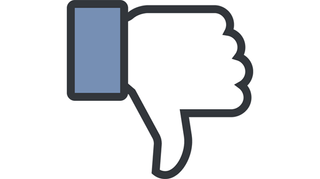Why Facebook's 'dislike' button could change the future of branding
Giving Facebook access to a wealth of new sentiment data has huge implications for brands.

Earlier this month, Facebook CEO Mark Zuckerberg stirred up a press storm by announcing that the network will finally be testing a 'dislike button'. Naturally, the news was met with a lot of excitement.
But what's the real story here? And how will this affect businesses who rely on Facebook to amplify their content?
Sources have confirmed that the new venture won't actually be as simple as a new 'dislike' button designed to direct negative sentiment. Facebook will in fact be testing a series of five new reaction buttons, allowing the user to express a range of five new sentiments towards a post or piece of content.
It's most likely that the buttons will represent a spectrum of positive to negative sentiment.
Sympathy vote
The 'dislike' button will be one of these five new reactions, however, in the interest of maintaining a positive user experience, it will be used as a means to express sympathy or empathy with existing negative sentiment.
For example, if one of your friends shares bad news, the empathy button will allow you to show solidarity, or give a virtual hug with the click of a button.
In essence, the new reaction series will allow users to express their feelings more realistically, as opposed to just clicking 'like'. So the story here is not so much the addition of a simple 'dislike' button, but it could mean the end of the 'like' button as we know it.
Why did Facebook do this?
Facebook's 'like' button has been a huge success in promoting user engagement. It's come to be an instantaneous way for users to say 'I saw your post, and I want to thank you for it', but it doesn't allow for any more than that.
You might 'like' a post even if it's referencing something negative, surprising, or politically sensitive. Facebook want to remove this friction, as Mark Zuckerberg explains in this short video:
User feedback has proved to the network that people want to be able to do more than just 'like', and maintaining user engagement is key for the powers that be at Facebook. Quick reactions are an effective way to promote engagement within the Facebook platform.
Often, you might want to show a reaction, but don't have time to write a comment or make the effort to share a post; a reaction button closes the barrier to engagement.
How will this affect my Facebook experience?
With a broader spectrum of reactions, users will become more comfortable with sharing and interacting with content that they don't necessarily agree with. If you have the option to show surprise, or discontent, you won't feel restricted by the notion of your Facebook activity reflecting on you personally.
An example of this is content that users consider to be important for public opinion; distressing images of world events or shocking news stories for example. People don't necessarily want to 'like' such content, but feel it's important to share.
The option to show solidarity with the intention behind sharing such content will cause news stories like this to spread faster on Facebook, and consequently, occupy more space within the platform.

This could lead the Facebook newsfeed to become a more realistic representation of the world we live in (cat videos watch out). It's likely that this will have significant implications for news publications, who are already becoming increasingly reliant on Facebook to direct traffic to their content.
What does it mean for businesses?
Facebook doesn't usually release updates simultaneously for public and private profiles. Remember the roll out of animated gif files? These were live for personal profiles before public pages, and it's very likely that reaction buttons will follow suit. Rolling out to personal profiles will allow Facebook to gather learnings and adjust for public pages.
As a business, when you push branded messaging out to your Facebook audience, some followers may actively engage, a small percentage may be moved to leave negative comments, and a large percentage may not find the message relevant and will simply ignore it.
The unmoved followers are now silent; they don't care enough to construct a negative comment, neither are they pushed to press 'like'. With a wider choice of reaction buttons, however, this silent group will have the opportunity to pollute your brand's content with negative reactions; there's a strong chance that they'll become more vocal.
Naturally, this is a potential hazard for brands, and marketing leaders should begin preparing for it to ensure the percentage of negative reactions is kept to a minimum.
There are two ways to do this. Firstly, if you haven't already done so, it's time to invest in a tool that registers the sentiment of your social audience when they engage with your brand. Identify what provoked your audience to express negative sentiment, and ensure that you adjust your content accordingly.
Secondly, ensure that your ad targeting on Facebook is accurate. The platform offers a nuanced system for ad targeting, and this will soon become more important than ever. Use social data to investigate the demographics of your social audience, and ensure that your ads are targeted to the people who will find them relevant.
A new frontier for sentiment analysis
Sentiment analysis is still a challenge for a lot of businesses. Natural language processing is difficult for many sentiment tools, particularly for contextual elements like irony and sarcasm, which are prominent parts of some cultures, but very hard to register textually.
Reaction buttons will mark a new phase of sentiment analysis in digital social interactions, a more granular way of registering sentiment. Brands will now benefit from knowing that x per cent of users reacted to a post with surprise, y per cent with excitement and so on.
Armed with this knowledge, Customer Intelligence professionals will be able to start data mining for more accurate audience insights, rather than a guesstimate from natural language processing.
When and where?
So when can we expect this to happen? My guess is that Facebook will be going live with a test version of the reaction series later this year, however it could be a long time before we see a final product. Bear in mind that if initial feedback to the test is negative, the product may not be rolled out at all.
One thing is for sure, the future of enterprise marketing will come to rely more and more on the nuances of social networks, so it's important to begin integrating your social efforts within the wider organisation, if you're not doing this already.
Words: Mikael Lemberg
Mikael is the director of product management at Falcon Social. A leading thinker in the field of social media development and strategy, and a former Facebook employee, Mikael is an authority on advertising strategies, product development and innovation management.
Like this? Read these!
- The designer's guide to working from home
- Discover the best blogging platform
- Download these free iPhone apps for designers

Thank you for reading 5 articles this month* Join now for unlimited access
Enjoy your first month for just £1 / $1 / €1
*Read 5 free articles per month without a subscription

Join now for unlimited access
Try first month for just £1 / $1 / €1
Get the Creative Bloq Newsletter
Daily design news, reviews, how-tos and more, as picked by the editors.
The Creative Bloq team is made up of a group of design fans, and has changed and evolved since Creative Bloq began back in 2012. The current website team consists of eight full-time members of staff: Editor Georgia Coggan, Deputy Editor Rosie Hilder, Ecommerce Editor Beren Neale, Senior News Editor Daniel Piper, Editor, Digital Art and 3D Ian Dean, Tech Reviews Editor Erlingur Einarsson and Ecommerce Writer Beth Nicholls and Staff Writer Natalie Fear, as well as a roster of freelancers from around the world. The 3D World and ImagineFX magazine teams also pitch in, ensuring that content from 3D World and ImagineFX is represented on Creative Bloq.
